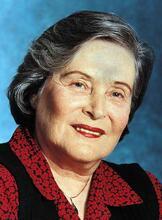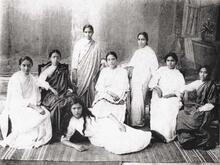Martha Wollstein
Responding to the public health crisis of the early twentieth century with a declaration that the current generation of women physicians had “entered societies and laboratories for the benefit of all,” Martha Wollstein had an exemplary career in pathology and the experimental study of childhood diseases. Following graduation from Cornell University Medical School, Wollstein interned at the Babies Hospital in New York, after which she remained in work as a pathologist for forty-three years. Later, Wollstein studied infectious diseases at the Rockefeller Institute and pursued research on diseases that disproportionately affect children. Wollstein was head of the pediatric section of the New York Academic of Medicine and was the first woman awarded membership in the American Pediatric Society.
In 1908, Martha Wollstein declared before the Women’s Medical Society of the State of New York that the current generation of women physicians had “entered societies and laboratories for the benefit of all.” Indeed, responding to the public health crisis of the early twentieth century, she herself had just begun an exemplary career path in pathology and the experimental study of childhood diseases.
Early life and education
Martha Wollstein was born to Louis and Minna (Cohn) Wollstein in New York City on November 21, 1868. Information about her family background is scarce. Her parents, both Jewish, had been born in Germany. She had one brother named Isaac.
From 1886 to 1889, Wollstein attended the Woman’s Medical College of the New York Infirmary. The college and its hospital offered women students education and training dedicated to the highest standards of professional excellence. It became part of Cornell University Medical School in 1909. The influence of this educational experience is clearly apparent in Wollstein’s publication of one of the earlier narratives written by American women physicians about their historical role in medical education and practice. She extolled the specific achievements of “medical women” in the past and cataloged women’s struggles to enter medical school, to find teaching, hospital, or laboratory positions, and to gain admittance to medical societies.
A career in pathology and childhood diseases
Following graduation, Wollstein completed a two-year internship at the Babies Hospital in New York City and was immediately awarded an appointment there as a pathologist. Her career with this institution would span forty-three years. She began her laboratory science career at a time when the medical community was beginning to believe in the possibility that diseases could be explained logically by discovering specific microorganisms. Wollstein conducted research on infant diarrhea, malaria, tuberculosis, and typhoid fever. Her work on infant diarrhea was recognized by the distinguished pathologist Simon Flexner, and the results of her research were published through the Rockefeller Institute for Medical Research. In 1906, she received an appointment as an assistant at the Rockefeller Institute, and in 1907, she began experimental studies in Flexner’s laboratory on the transmission of polio. Her efforts to find “evidence of a micro-parasitic origin of the disease” in research with infants and children were unsuccessful, but they contributed to future polio research on humans and monkeys.
Between 1910 and 1920, Wollstein studied a variety of infectious diseases at the Rockefeller Institute. She looked at possible causal relationships between different bacteria and differing types of pneumonia with the physiologist Samuel Meltzer. With Harold Amoss, she contributed to developments in serum treatment for meningitis. In an independent experimental study of mumps, Wollstein used saliva filtrate from sick children and from soldiers in Army camp hospitals near New York City. She was able to inject the disease from these groups of patients into cats and then from cat to cat, suggesting, but not proving, the viral nature of mumps. She was the first researcher at the Rockefeller Institute to publish a scientific study that described the significance of the bacteriophage discovered by Felix D’Herelle.
From 1921 until her retirement in 1935, Wollstein pursued research on children’s diseases, including tuberculosis and leukemia, at the Babies Hospital. Over several generations, her pathological studies supported the work of clinical physicians and public health workers in their common struggle to ascertain the ways bacteria were transmitted, diagnose patient illness, and mount effective campaigns to eliminate infectious disease.
Legacy
In 1928, Wollstein was appointed head of the pediatric section of the New York Academy of Medicine. In 1930, she became the first woman awarded membership in the American Pediatric Society. While Wollstein worked with and for male Jewish colleagues who were among the early members of the Rockefeller Institute, she was not given this privilege. Indeed, only one woman received this acknowledgment in the institute’s first fifty years.
By the time Martha Wollstein retired to Grand Rapids, Michigan, in 1935, she had authored eighty scientific papers. However, professional acclamation did not follow her death on September 30, 1939, at Mount Sinai Hospital in New York City. Her New York Times obituary stated merely that she “was also known as a pathologist... ” Yet Wollstein’s achievements clearly merit recognition beyond the “also known” distinction. Her prominence among the first group of American women physicians to conduct original research in pathology at distinguished American hospitals and research institutes is undeniable.
Selected Works by Martha Wollstein
“A Biological Study of the Cerebro-Spinal Fluid in Anterior Poliomyletis.” Journal of Experimental Medicine 10 (July 1908): 476–483.
“An Experimental Study of Parotitis.” Journal of the American Medical Association 71 (1918): 639–644.
“The History of Women in Medicine.” The Woman’s Medical Journal 18 (1908): 65–69
“Studies on the Phenomenon of D’Herelle with Bacillus Dysenteria.” Journal of Experimental Medicine 34 (November 1921): 467–476.
“A Study of Tuberculosis in Infants and Young Children.” American Journal of Diseases of Children 21 (January 1921): 48–56.
BEOAJ; Hurd-Mead, Kate Campbell. Medical Women of America (1933).
Kagan, Solomon R. Jewish Contributions to Medicine in America (1939).
Kaufman, Martin, et al., eds. Dictionary of American Medical Biography (1984).
Marcus, Jacob R. The American Jewish Woman, 1654–1980 (1981).
Morantz-Sanchez, Regina. Sympathy and Science: Women Physicians in American Medicine (1985).
NAW; Obituary. NYTimes, October 1, 1939, 53:2.
“Reports to the Board of Scientific Directors.” Rockefeller Institute for Medical Research (1907–1920).
WWIAJ (1938).











